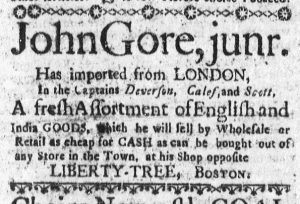What was advertised in a colonial American newspaper 250 years ago this week?

“All the above is the Produce & Manufacture of North-America.”
John Gore sold paint and supplies at his shop at “the Sign of the PAINTERS ARMS, in Queen-Street” in Boston in the late 1760s and early 1770s, a curious time to peddle those products. In addition to imported paper, tea, glass, and lead, the Townshend Acts imposed duties on imported paint. In response to such taxes, colonists in Boston and other cities and towns organized nonimportation agreements that covered a vast array of goods. They intended to use economic pressure to convince Parliament to repeal the Townshend Acts.
Given how politics affected commerce, Gore quite carefully enumerated the items he offered for sale at his shop. He led his advertisement with linseed oil, turpentine, varnish, lacquer, and “very good red, black and yellow Paints.” He then explicitly stated that “All the above is the Produce & Manufacture of North-America.” In other words, he had not violated the nonimportation agreement; prospective customers could safely purchase those items from him without sacrificing their own political principles. Furthermore, he demonstrated his commitment to the cause by offering “domestic manufactures” as an alternative to imported goods. In addition to the Townshend duties, colonists in Boston and elsewhere expressed concern about a trade imbalance with Britain. Many advocated producing goods in the colonies as a means of reducing dependence on imports. Buying and selling goods produced in North America thus served several purposes, including boosting local economies and providing employment for the colonists who made those goods. Advertisers often listed such outcomes when they simultaneously encouraged consumers to purchase domestic manufactures to achieve political purposes. Although Gore did not do so in this advertisement, he likely expected that many readers would make such arguments on his behalf, having encountered them so often in public discourse.
Selling goods produced in the colonies, however, did not prevent Gore from peddling imported goods as well. After first promoting merchandise from North America, Gore then noted that he also carried “An Assortment of Colours” but carefully explained that they had been “imported before the Agreement of the Merchants for Non-importation took Place.” Gore still had inventory imported from England to sell. Rather than take a loss, he stated the terms under which he had acquired those goods. Their presence alongside “the Produce & Manufacture of North-America” quietly testified to the fact that even though colonists attempted to devise appropriate substitutes for many imported goods they were not positioned to sustain themselves. Political rhetoric did not necessarily reflect the realities of commerce, production, and consumption in eighteenth-century America. Gore structured his advertisement to assert as much political virtue as possible in an imperfect situation.


